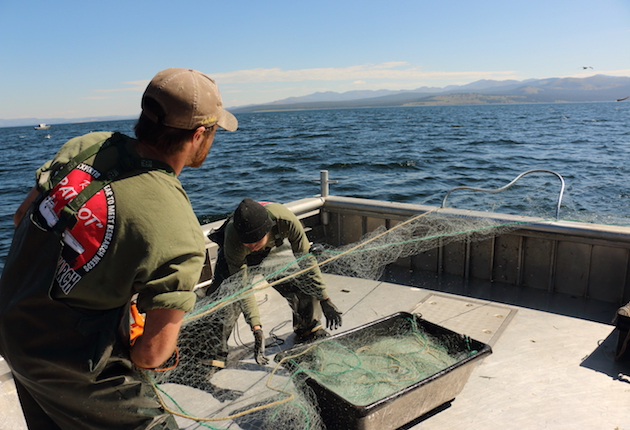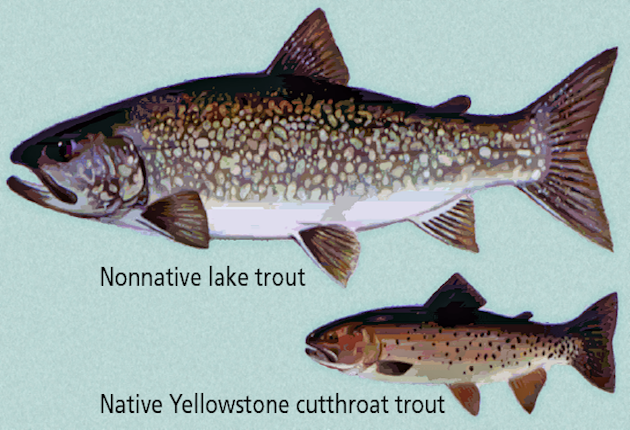“This is your fault. You screwed up. You should have done something earlier.”
This is how my day with Todd Koel starts. Koel is Yellowstone National Park’s native fish conservation leader. We’re standing on a boat ramp while a park visitor lays into Koel in front of me and a few other journalists. We’re about to get on a boat bound for Yellowstone Lake, but this visitor cornered Koel first.
Koel keeps his cool while the man spouts. When he’s done, Koel calmly acknowledges there is a lot of passion involved when it comes to the park. Koel’s boss agrees.
“Everything in Yellowstone National Park is a controversy,” says Dan Wenk, park superintendent. “And I’m glad it is because it means people care.”
I’m here to see what they care about. We launch after the awkward exchange and motor to the middle of the lake. That’s where a commercial fishing crew from the Great Lakes region is catching lake trout with up to 40 miles of netting.

Todd Koel navigates Yellowstone Lake while talking about killing invasive lake trout to save native Yellowstone cutthroat trout. (Photo: Kris Millgate/www.tightlinemedia.com)
This is the epicenter of the angry visitor’s angst. Lake trout are not native to the park. An angler caught the first one in 1994. By the mid-2000s, lake trout had eaten 90 to 95 percent of the native Yellowstone cutthroat trout in the lake. Commercial gillnetting to kill lake trout went gangbusters in 2009.
“The problem is lake trout are like large wolves on the landscape, only in the lake,” Koel says. “Large, highly predatory, fish-eating machines essentially.”
From May through October 300,000 lake trout are netted, killed, and dumped back into the lake as decomposing nutrients. The effort is time intensive and wallet consuming, costing $2 million annually.
“It is fixable, but it’s not an easy fix. It takes an incredible amount of dedication by a lot of people,” says Dave Sweet, Wyoming Trout Unlimited Yellowstone Lake special project manager. “It’s a very expensive proposition, but it is fixable. We just have to crash that population of lake trout and then figure out a way to keep that population crashed and the cutthroat will come back on their own.”
The crash is close. After seven years of concentrated effort, the fishery is showing signs of change. An estimated 40 other types of wildlife consider cutthroat trout part of their diet. When those fish disappeared, the animals left the lake. This summer, eagles are circling and grizzlies are back on the banks.
“The population of lake trout in general is about half of what it was just a few short years ago. That makes me very happy,” Sweet says. “What really makes me happy is the cutthroat population in that same time period has been able to recover, and it’s about three times what it was a few short years ago. We’re seeing a lot of progress.”

More than 30 miles of netting is in Yellowstone Lake on any given day from May through October. The nets collect and kill 300,000 unwelcome lake trout annually. (Photo: Kris Millgate/www.tightlinemedia.com)
That progress is piled in black bins on the gillnetting boat. Hundreds of dead lake trout are brought in while more netting goes out. Koel cuts lake trout bellies open and often finds up to eight small cutthroats inside. With so many fish still coming on board, it’s hard to see a population crash coming, but Koel is convinced it is.
This year is the operation’s halfway mark. Koel has five to seven more years to go, but the tide is already turning, despite the tourists yelling at him on the boat ramp.
“We know we’ll never totally get rid of lake trout. That’s a fact,” Koel says. “We don’t have the technology to do that, but what we can do is suppress the population, control the population, and keep lake trout at a low enough level to allow cutthroat to return to an abundance that makes them again ecologically important in the ecosystem.”
Kris Millgate is an outdoor journalist based in Idaho Falls, Idaho. See more of her work at tightlinemedia.com.

